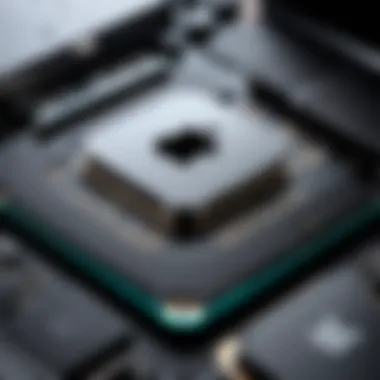Assessing MacBook Processors: Performance and Innovation


Intro
As we step into an era where computing power dominates our professional and creative tasks, the processors that drive our devices have become focal points of discussion. The landscape has shifted notably with Apple’s transition from Intel to its in-house M-series chips. This change didn’t just reshuffle the components under the hood; it redefined our expectations for hardware performance, energy efficiency, and overall user experience. With each iteration, Apple pushes the envelope of what is possible in mobile computing, making it crucial for both IT professionals and tech aficionados to understand the intricacies involved.
The latest iterations of MacBook processors showcase more than just raw performance; they embody significant architectural innovations. What sets these processors apart? How do they perform under varying loads? These are the questions we'll delve into, unraveling the mechanics behind them.
Overview of Hardware/Software
Foreword to the Product and Its Key Features
Apple’s M-series processors, like the M1, M1 Pro, M1 Max, and more recently M2, represent a paradigm shift in how laptops are built. Not only do these chips integrate the CPU and GPU onto a single die, but they also optimize the neural engine for machine learning tasks. This synergy leads to enhanced performance metrics and sprinkled in the mix of versatility, these processors are designed with the modern professional in mind.
Specifications and Technical Details
Let’s break down some core specs that matter:
- M1: 8-core CPU, 7/8-core GPU, up to 16GB unified memory, and superior power efficiency.
- M1 Pro: An even beefier 10-core CPU, 16-core GPU, supporting up to 32GB memory.
- M1 Max: Takes it up another notch with a staggering 10-core CPU and up to a 32-core GPU, enabling up to 64GB unified memory.
- M2: Further refinements over M1 with enhancements in GPU architecture, better memory bandwidth, and improved performance for multithreaded tasks.
These specs are par for the course in high-performance computing, especially for those deep in creative and tech-heavy workplaces.
Pricing and Availability
Price tags can vary dramatically based on configurations, ranging generally from $999 for base models to well beyond $3,000 for maxed-out versions. Depending on what you need, the investment can feel hefty, but consider it against the backdrop of performance and future-proofing.
Comparison to Previous Versions/Models
When stacked against previous Intel-based MacBook models, the differences are stark. The M1 chips deliver battery life previously unheard of in this space, often stretching up to 20 hours under even general usage. The stark contrast is best summarized by user reports, noticing significant boosts in workflow efficiency and speed when moving to M1 or beyond.
Pros and Cons
Highlighting the Strengths and Weaknesses of the Product
- Pros:
- Cons:
- Exceptional performance in daily tasks and demanding applications.
- Eye-popping power efficiency resulting in longer battery life.
- Seamless integration of hardware and software leading to optimized workflows.
- Limited compatibility with legacy software traditionally run on Intel architecture.
- Pricey configurations can be a hurdle for budget-conscious buyers.
User Feedback and Reviews
User experiences reflect a mixed bag of sentiments. Many laud the performance leaps, while some raise eyebrows at the software transition and potential limitations of older app compatibilities. In the grand scheme, the overwhelming consensus favors innovation, marking a significant step ahead for Apple’s computing devices.
Performance and User Experience
Performance Testing Results
Real-world tests have shown M-series processors trouncing older Intel-based counterparts in various applications. For instance, video rendering tasks in Final Cut Pro can see an almost 3x increase in speed with M1 Max compared to Intel’s i9 processors.
User Interface and Ease of Use
User interfaces remain smooth and responsive when paired with these processors. MacOS has cleverly been optimized to leverage the unique capabilities of the M-series, ensuring that users don’t stumble over hiccups commonly encountered in less integrated systems.
Real-world Usage Scenarios
Whether running intensive applications like graphics design software or engaging in multitasking with several windows open, the processors maintain fluidity and speed. Professionals focused on video editing, software development, and 3D modeling find these machines particularly appealing due to their power and adaptability.
Efficiency and Productivity Impact
In terms of productivity, users often report a noticeable reduction in the time to complete tasks. M-series computers change the game, ensuring the performances remain at their peak even when under heavy load. This resilience translates into smoother workflows, allowing professionals to accomplish more in less time.


Innovation and Trends
Industry Trends Related to the Product Category
The shift to ARM-based architectures represents a notable trend in the tech world. Companies exploring similar paths could understand the efficiency and performance trade-offs Apple has navigated with its M-series adaption.
Innovative Features and Functionalities
Innovative features like universal control and improved machine learning capabilities provide unique advantages that might redefine the approach towards productivity in the tech field. The M-series processors are embedded in an ecosystem that promotes not just innovation but captures holistic user experience in their design.
Potential Impact on the IT Industry
As more industry players catch wind of Apple's advancements, we might witness further investments in similar propulsion towards specialized processors. The evolving landscape of Chip design could reshape future IT solutions.
Recommendations and Epilogue
Overall Verdict and Recommendations
When it boils down to it, if you're in the realm of high-performance computing, the M-series chips are hard to go past. They bring forth undeniable improvements in performance, efficiency, and overall user satisfaction.
Target Audience Suitability
The ideal audience for these devices spans from creatives needing heavy-duty computing power to IT professionals looking for reliability. The necessity to accommodate future workloads makes these processors a sound investment.
Final Thoughts and Future Prospects
Looking ahead, as new models trickle down the pipeline, it is intriguing to ponder where Apple will steer its M-series. Will enhancements extend to even broader areas of artificial intelligence or other realms? One thing remains clear: the spotlight is firmly placed on performance and innovation, with Apple leading the charge.
"Understanding the processors that drive our devices is key to maximizing productivity and innovation in an ever-evolving tech landscape."
The Evolution of MacBook Processors
The shift in computing power within MacBooks has taken some interesting turns over the years. Understanding the evolution of MacBook processors provides crucial insight into the performance and efficiency enhancements that Apple has pioneered. It's not just a story of technological progress; it's about how these changes affect the daily experience of professionals across various sectors. Particularly for tech enthusiasts and IT specialists, grasping the history and context of these processors can illuminate how they influence hardware choices and task performance in real-world applications.
From Intel to Apple silicon
The transition from Intel processors to Apple silicon has been nothing short of groundbreaking. When Apple first partnered with Intel in 2006, it marked a significant change in performance and compatibility. These processors delivered substantial power, enabling MacBooks to run high-end applications seamlessly. But as time passed, limitations became evident. Intel chips, while robust, often lagged behind in energy efficiency and hardware integration. Apple recognized this gap and took a bold step.
In 2020, Apple introduced its first Apple silicon, the M1 chip. This shift has redefined what a MacBook can be. Apple silicon offers impressive performance metrics alongside unmatched efficiency. This means not only can the devices handle demanding software but they also do so while conserving battery life—a critical factor for users on the go. The M1 chip runs near-silently and keeps temperatures low, enabling longer sessions without overheating, something that was a concern with many Intel models.
Key Milestones in Processor Development
In evaluating the trajectories in processor development, several milestones stand out. Let's take a closer look:
- Introduction of M1 Chip (2020): A game changer for the MacBook lineup, setting the stage for future Apple processors. Its performance in CPU and GPU tasks has placed it on par with some of the best offerings from Intel and AMD.
- Launch of M1 Pro and M1 Max (2021): These chips expanded upon the M1, offering enhanced capabilities for professional users tackling memory-intensive projects, such as video editing or software development.
- The M2 Chip (2022): Building on the success of its predecessors, the M2 brought further architectural advancements and improved speed, which caters to an even broader range of professional applications.
These milestones speak volumes about Apple's commitment to innovation and performance. As evident from the evolution of the MacBook processors, the push towards in-house designs has allowed for products that better meet the specific needs of their users, making computing not only more powerful but also more tailored than ever.
"The best processors are not just about raw power, but also about efficiency and adaptation to user needs."
By understanding these key developments, users can not only appreciate the engineering prowess behind the devices they utilize but can also make more informed decisions regarding which MacBook might best suit their particular needs.
Overview of Apple's M-Series Processors
The emergence of Apple's M-Series processors represents a significant turning point for the MacBook lineup. Previously reliant on Intel, Apple's decision to go in-house with their silicon has ushered in a new era of performance and efficiency. This section dives into the critical aspects of the M-Series, making it essential reading for anyone keen on understanding the current state and future trajectory of MacBook processors.
The M-Series signifies more than just a change in chip supplier; it embodies Apple's commitment to optimizing both performance and energy efficiency. Each iteration, from the M1 to the M2, has brought incremental improvements that cater to the growing demands of both casual users and professionals.
M1: A Game Changer
The M1 chip was not merely a new processor; it was hailed as a game changer in the tech world. Released in 2020, it integrated several functionalities into a single chip, commonly referred to as a System on a Chip (SoC). This includes the CPU, GPU, Neural Engine, and memory, allowing for much faster processing times and better graphics performance. Users noticed a huge leap in speed compared to earlier Intel-based models.


Its performance on single-core tasks was exceptional, making tasks like web browsing, word processing, and even video editing feel remarkably smooth. For the everyday user, this translates to increased productivity and a more enjoyable experience.
M1 Pro and M1 Max: Enhanced Capabilities
Riding on the momentum of the M1, Apple released the M1 Pro and M1 Max. These chips are designed specifically for professionals who need extra power for demanding tasks. The Pro model, featuring up to 10 CPU cores and 16 GPU cores, offers enhanced performance for software like Final Cut Pro and Logic Pro. It handles multitasking with grace, allowing users to run multiple demanding applications simultaneously without breaking a sweat.
The M1 Max takes it further, presenting a whopping 32 GPU cores, making it suitable for high-level graphics work, AI processing, and even gaming. For professionals in fields such as video production, 3D rendering, and software development, these chips provide the horsepower needed without sacrificing energy efficiency.
M2: Building on Success
With the introduction of the M2 chip, Apple continued to build on its foundation of success established by the M1 lineup. The M2 showcases advancements in architecture that further amplify performance capabilities while still maintaining low power consumption.
The M2 integrates features such as higher memory bandwidth and additional graphics cores compared to its predecessor. This translates to better performance in video editing, complex computations, and even rendering high-resolution images. It’s designed for future-proofing the MacBook lineup while still being accessible for mainstream users.
"The shift to M-Series is a testament to Apple's vision in creating not just hardware, but a seamless experience for its users."
By focusing on the M-Series, this section underscores the critical developments that significantly influence both user experience and the broader landscape of computing technology.
Performance Benchmarks of MacBook Processors
Evaluating the performance of MacBook processors is crucial for both consumers and IT professionals. As technology moves forward, understanding how these chips perform under various conditions helps make smarter decisions. Knowing not just how fast a processor is, but how it compares with others in the real world, can impact everything from daily tasks to demanding professional workloads. Performance benchmarks offer a snapshot of a processor’s capabilities, focusing on crucial elements such as speed, efficiency, and overall user experience. This knowledge is beneficial when considering which MacBook to purchase or upgrade, ensuring you get the best bang for your buck.
Comparative Analysis with Competitors
When looking at any MacBook processor, a comparative analysis sheds light on its standing against alternatives. For instance, Apple's M1 chip made waves by not only outperforming many Intel processors but also rivaling some high-end AMD chips. The unique architecture of the M1 leverages ARM technology, which, unlike its competitors, shows remarkable efficiency in handling multi-threaded tasks without sacrificing battery life.
Key comparisons to keep in mind include:
- Single-Cores Performance: Apple’s M-series chips often excel in single-core benchmarks, shining in tasks like web browsing and app launching.
- Multi-Cores Performance: In multi-core scenarios, however, competition heats up, particularly from AMD’s Ryzen chips. The balance of cores and threads plays a vital role here.
- Integrated Graphics: The integrated graphics capabilities of M1, M1 Pro, and M1 Max processors stand out, often leaving Intel’s Iris Xe in the dust.
Of course, performance isn’t everything. Price and the overall system optimization must factor in, too. Benchmarks are essential but they should be taken in context.
Real-World Usage Scenarios
Benchmarks in controlled environments can be insightful, yet real-world scenarios tell a different story. IT professionals and tech enthusiasts truly assess processors based on their everyday performance against practical demands.
Let's delve into a few scenarios:
- Video Editing and Rendering: For professionals in video production, tasks can be processor-intensive. Users have noted that the M1 Max significantly reduces render times, outperforming Intel models like the Core i9.
- Software Development: Running multiple virtual machines or compiling code can strain processors. Here, the M2 manages resources deftly, allowing smooth operations without hiccups.
- Everyday Tasks: Simple tasks like browsing or document editing expose the robustness of Apple’s processors. Their quick response times enhance user satisfaction in time-sensitive environments like office work.
These real-life experiences demonstrate how processor performance translates into tangible benefits for users from various fields.
Gaming and Graphics Performance
Gaming on a MacBook is no longer an unusual concept, but performance can vary significantly depending on the processor and GPU working in tandem. Apple’s M-series chips, particularly the M1 Pro and M1 Max, offer impressive performance even in graphically demanding titles, challenging the notion that Macs are unsuitable for gamers.
- Frame Rates: In games like Shadow of the Tomb Raider, players have reported commendable frame rates that rival those of dedicated gaming laptops, attributing this success to optimized graphics architectures.
- Thermal Throttling: One major advantage of these processors is their thermal management. Unlike many of their competitors, M-series chips handle heat well, maintaining performance during extended gaming sessions.
- Supports Resolution: Gaming at higher resolutions is also feasible with M-series chips, where users can crank up the visuals without noticeable drops in performance.
Overall, the gaming and graphics performance of MacBooks reflects Apple’s shift towards catering to a more diverse audience, merging professional tasks with gaming enjoyment.
"In a landscape often dominated by perceptions, Apple's M-series processors have quietly reshaped how users view MacBooks - both as tools and entertainment devices."
Understanding the benchmarks set by these processors provides valuable insights, guiding savvy buyers in selecting their next MacBook.
Energy Efficiency and Thermal Management
In the realm of computing, where performance usually takes center stage, energy efficiency and thermal management often lurk in the shadows. However, for MacBook processors, these elements represent a critical balancing act that significantly affects their usability, longevity, and overall user experience. As IT professionals and tech enthusiasts dive into the intricate landscape of MacBook technology, understanding these facets becomes imperative to selecting the most suitable machine for specific needs.
Power Consumption Metrics
When discussing power efficiency in MacBooks, the power consumption metrics provide quantifiable insights into how processors utilize energy throughout their operation. Apple has meticulously designed its M-series processors to optimize energy usage without sacrificing performance.


- TDP (Thermal Design Power): This figure suggests how much power a processor consumes at maximum capability. The M1 chip, for instance, showcases a TDP of around 10-15 watts, which is notably lower than many Intel counterparts. This lower power draw translates to extended battery life for users, a non-negligible advantage for those who run demanding applications.
- Performance per Watt: An essential consideration is how well a chip delivers performance while consuming power. Apple's M-series has proven adept at maximizing this ratio, offering robust performance with minimal energy expenditure. This efficiency means more tasks can be processed on battery power, freeing users from being tethered to outlets.
- Dynamic Scaling: MacBooks leverage dynamic frequency scaling—adjusting the processor’s frequency based on workload. This capability ensures that the system consumes only what is necessary, furthering efficiency. Building on this feature allows users to work longer while enjoying a responsive performance during intensive tasks.
"The notion that more power directly equates to better performance is being challenged as efficiency becomes the new king in processor design."
The intricate interplay of these metrics forms the backbone of any energy-efficient device, providing tangible benefits in terms of battery life and overall sustainability.
Cooling Solutions Integrated Into MacBooks
As the demand for performance grows, so does the challenge of heat management. High-performance chips can generate notable heat, which, if unmanaged, can lead to throttling and diminished performance. Apple has implemented several cooling solutions in its MacBook lineup to tackle this hurdle effectively.
- Passive Cooling: A hallmark of the M1 MacBook Air is its completely fanless design. This unit relies on a passive cooling system, utilizing the aluminum chassis and thermal conductivity to dissipate heat naturally. This not only results in silent operation but also aids in prolonging hardware life by minimizing wear on mechanical components.
- Active Cooling: For models like the MacBook Pro with M1 Pro and M1 Max chips, an active cooling system is employed. This system consists of a more traditional fan setup that is strategically designed to operate quietly under load while ensuring optimal airflow to keep the processor within safe temperature limits.
- Thermal Interface Materials: Apple uses high-quality thermal interface materials (TIM) between the CPUs and their heat sinks. These materials improve thermal conductivity and enhance the efficiency of heat dissipation.
Ultimately, the combination of these cooling techniques paves the way for sustained performance across various workloads, regardless of whether it’s graphic design, video editing, or programming—ensuring that MacBooks remain cool under pressure.
Understanding the critical aspects of energy efficiency and thermal management is essential for making informed decisions about MacBook processors. Improved power consumption and innovative cooling solutions not only enhance usability but also ensure that these devices maintain their performance edge while addressing the sustainability concerns of today’s tech landscape.
Future Trends in MacBook Processing Technology
When looking at the landscape of technology and the ever-evolving needs of users, understanding potential trends in MacBook processing technology becomes crucial. Not only does it guide IT professionals and tech enthusiasts in making informed purchasing decisions but it also sets the stage for future innovations. As Apple continues to forge its path with its proprietary silicon, observing trends can help predict upcoming performance increases and enhancements that could redefine work and leisure experiences.
Potential New Architectures
The MacBook processors are poised to evolve with new architectures that may offer significant advantages. This transition can influence not only raw performance but also integration with other hardware and software ecosystems.
- Modular Design: There's increased chatter around modular processing architecture, allowing users to upgrade parts without changing entire systems. This approach can enhance longevity and let users tailor their machines to specific needs.
- Hybrid Architectures: The blending of CPU and GPU performance could yield remarkable outcomes. Think of tasks like video rendering or heavy data processing becoming less burdensome due to machines that effectively distribute workloads between different processing units.
- ARM Innovations: With Apple’s sustained focus on ARM-based processors, advancements here might yield better performance and efficiency. This allows for longer battery life and cooler operational temperatures, important factors for professionals constantly on the move.
"Innovation is the ability to see change as an opportunity - not a threat."
— Anonymous
As these new architectural designs pave their way into the MacBook family, users could see a notable uptick in graphics capabilities and processing power, providing more robust tools for creative tasks, be it graphic design or software development.
The Role of Artificial Intelligence
Artificial intelligence is already reshaping many industries, and its integration into MacBook processors is expected to further enhance user experiences. From automating tasks to optimizing performance, AI could redefine how users interact with their devices.
- Performance Optimization: AI algorithms can learn usage patterns, adjusting power distribution and boosting performance as needed. This means tasks that require heavy processing can be accelerated while routine tasks might consume less energy.
- Enhanced User Interface: Imagine a MacBook that understands commands and responds intuitively to your needs! By leveraging voice recognition and predictive text inputs, AI can make interacting with technology far more seamless.
- Self-Diagnostics: Integrating AI allows devices to perform self-checks, predicting possible hardware or software failures before they become critical. This predictive maintenance could save users from unexpected downtimes.
In summary, the future of MacBook processors lies in architectural advancements and AI integration. By adopting these emerging trends, Apple can continue to provide robust and adaptable products that resonate deeply with professionals and enthusiasts alike.
Practical Considerations for IT Professionals
As technology evolves, the landscape of personal computing continues to shift. For IT professionals, understanding these changes is crucial. The rise of Apple’s M-series processors signifies a watershed moment, providing not just enhancement in computing power but also innovative architectural methods. In this section, we probe into practical considerations vital for decision-making when selecting a MacBook, focusing on how these elements affect daily operations and long-term strategy.
Selecting the Right MacBook for Your Needs
When it comes to choosing a MacBook, the focus shifts towards specific requirements and user scenarios. Each model presents its own unique selling points, demanding a thorough consideration of tasks at hand. Here are some key points to mull over:
- Performance Requirements: What will the MacBook mainly be used for? Simple tasks like web browsing and document editing require different processing capabilities than heavier applications for video editing or software development.
- Memory and Storage: The balance of RAM and storage is essential. A machine with 16GB of RAM and a decent SSD will serve most users well for multitasking and ensuring smooth operation, particularly in professional environments.
- Battery Life: Professionals who are often on the move would benefit significantly from extended battery life. Models like the MacBook Air with M2 chip exemplify superior endurance, allowing for longer work sessions without frequent plug-ins.
By combining such elements, IT pros can tailor their choices to meet both immediate needs and long-term performance expectations, ensuring they aren't caught flat-footed.
Long-term Viability and Upgrade Paths
Investing in technology is often a balancing act. IT professionals have to consider current needs alongside future requirements. The MacBook M-series processors not only offer power today but pose questions about their durability and adaptability over time.
- Future-Proofing: With rapid advancements in software and applications, selecting a MacBook equipped with the latest M-series chip is a wise investment. These chips are designed to handle not just current workloads but future demands, thanks to scalability in performance and compatibility.
- Upgrade Options: While Apple generally discourages user upgrades post-purchase, understanding which models allow for configuration at the point of sale can extend the usability of a device. Evaluating options like maximum memory and storage at the time of purchase will pay off, allowing the machine to adapt as software requirements evolve.
- Resale Value: MacBooks tend to hold their value over time, making them a smart buy for IT departments. If a significant upgrade becomes necessary, the ability to resell old equipment can help offset new purchases.
In summary, the choices IT professionals make regarding MacBooks can have lasting implications, from immediate performance to long-term viability. Each consideration shapes the overall experience and adaptability of their technology in an ever-changing digital landscape.
Epilogue
As we draw this discussion to a close, it’s clear that the evolution of MacBook processors has set a new benchmark in both performance and innovation. The shift from Intel chips to Apple's own M-Series has not only transformed the MacBook experience but also redefined the expectations for computing power in portable devices. Understanding this transition is crucial for both IT professionals and tech enthusiasts alike.
Summarizing Key Insights
- Performance Metrics: The Apple M-Series, particularly the M1, M1 Pro, M1 Max, and the M2 chips, have demonstrated exceptional performance in various benchmarks. They not only compete with but often surpass traditional rivals in processing speed and efficiency.
- Energy Efficiency: Apple's focus on energy efficiency means these processors consume less power while delivering superior output. This is a significant consideration for those in resource-conscious environments.
- Real-World Applications: Each processor’s suitability varies based on user needs. Whether for intensive graphic design work or software development, the M-Series provides tailored options adept at handling complex tasks without breaking a sweat.
- Future Outlook: Emerging trends indicate that further advancements in processing technology, including potential new architectures and enhanced AI integration, may shape upcoming MacBook models. Users should remain informed on these developments to make wise purchasing decisions in the future.
In summary, appreciating the intricate details of each processor's capabilities will empower users to select the best MacBook suited to their professional or personal needs. Choosing the right chip not only impacts current performance but also ensures the longevity and adaptability of computing equipment in a fast-evolving digital landscape. Therefore, investing time into understanding these processors is not merely an exercise for the technically inclined; it is a vital aspect for anyone striving for efficiency and excellence in their work.



